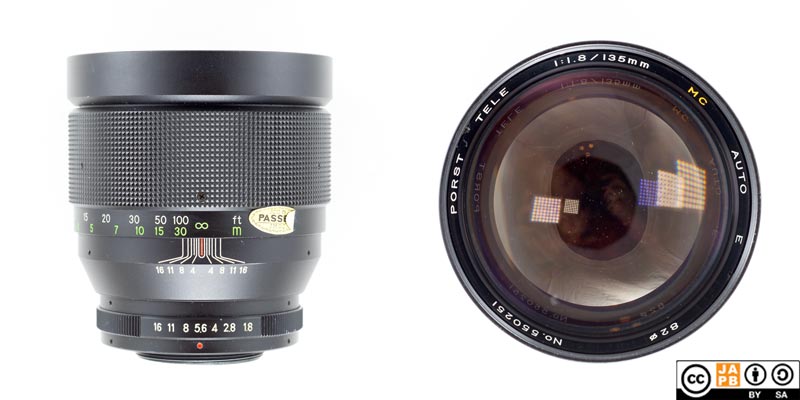Pekka Buttler, 09/2023

Specifications
The table below summarises the lens’ key specifications (measurements based on pictured sample):
| Brand: | Porst | Lens name | Tele 1:1,8/135 mm MC AUTO |
| Focal length 1 | 135 mm | Angle-of-view 2 | ≈18° |
| Maximum Aperture | f/1.8 | In Production | ≈1960s–70s |
| Lens mount | M42 | Subfamily (if applicable) | –– |
| Length 3 | 91,2 mm | Diameter 4 | 84,9 mm |
| Filter ring diameter | 82 mm | Weight | 806 grams |
| Lens element count | ? | Lens group count | ? (see below) |
| Aperture blades (S/R/C) 5 | 8 S | Focus throw | ≈180 ° |
| Minimum focusing distance | 1,7 m | Maximum magnification | 1:10,5 |
| Has manual aperture ring | YES | Has Manual focus ring | YES |
| Aperture mechanism type | Automatic /manual | Aperture click stops 6 | 1.8-2.8-4-5.6-8-11-16 |
Further notes:
• The mainline specifications – 135 mm and f/1.8 – are enough to make this lens interesting.
• The lens is quite heavy. On the other hand, compared to its main rivals (e.g. Nikkor 135/2 @ 860 grams) the lens is not especially hefty.
A mystery:
• Regarding the origins of this lens, there are two versions.
• According to one version this lens was originally designed and manufactured my Mitake Optical – a relatively little known Japanese OEM manufacturer, and carries a 5 elements in 4 groups design (only the rearmost elements are cemented. Such a lens was sold by several rebranders, including (but not necessarily limited to) Porst, Apollo, Beroflex, Spiratone, and Weltblick.
• According to another version, this lens is optically similar only to the Soligor 135 mm f/1.8 lens of old (the T-thread version) and is optically a close relative of the Zeiss Olympia Sonnar (see Olympia Sonnar on JAPB and on zeissikonveb.de), uses a 5 elements in 3 groups design (central cemented triplet) and was designed and manufactured by Tomioka or Tokina.
• As I have not yet had a reason to open this lens, I do not know which version is true (but I will report back as soon as I have hard facts).
• For now I can only say that the lens has significant outward commonalities with other Mitake-made lenses in my inventory.
History
See the JAPB Company profile on Porst for more information on the company.
Porst sourced its lenses widely. While some of Porst lenses were direct rebrands of identical lenses of major brands, most were sourced from (mostly Japanese) off-brand/OEM manufacturers. While one cannot often say anything precise about the origins of lenses sourced from Japanese OEM’s some of the samples of the 135 mm f/1.8 have “By Mitake” in the lens’ name ring.
Adapting
If you want to natively mount this lens you need to find a functioning m42 mount film camera. Luckily that should be relatively easy as m42 bodies were produced in their millions and most of them lack features that are especially likely to have deteriorated to the point of making the entire camera inoperable.
Adapting this lens to a mirrorless, full-frame digital camera is a breeze thanks to the lens having full manual controls (aperture ring, focus ring). You simply need a dumb adapter from m42 to your mirrorless system (And set the lens in manual mode to be sure the aperture works as you intend).
Due to the medium flange focal distance used by the m42 mount (45,46 mm), whether you can adapt this lens to dSLR/SLR mounts depends on which dSLR mount: Canon EF, Four Thirds, Minolta/Sony A and Pentax K can mount m42 lenses using a simple adapter ring. Nikon F on the other hand is not as problem-free, and – to retain anything near infinity focus – the adapter will necessitate corrective optics. In all cases, your camera will work only in stop-down metering.
Footnotes
- Focal length is (unless stated otherwise) given in absolute terms (not in Full-frame equivalent), and according to the manufacturer’s naming practice (which does not always reflect the lens’ actual field of view). For an understanding of whether the lens is wide/tele, see ‘Angle-of-view’. ↩︎
- Picture angle is given in degrees and concerns the diagonal picture angle. Rule of thumb:
> 90 ° ==> Ultra-wide-angle
70–90 ° ==> Wide-angle
50–70 ° ==> Moderate wide-angle
40–50 ° ==> ‘Standard’ or ‘normal’ lens
20–40 ° ==> Short tele lens
10-20 ° ==> Tele lens
5-10 ° ==> Long tele lens
< 5 ° ==> Ultra-tele lens ↩︎ - Length is given from the mount flange to the front of lens at infinity. Measured unless stated otherwise. ↩︎
- Diameter excludes protrusions such as rabbit ears or stop-down levers. Measured unless stated otherwise. ↩︎
- S=straight; R=rounded; C=(almost)circular at all apertures. ↩︎
- Numbers equal aperture values on aperture ring; • intermediate click; – no intermediate click. ↩︎